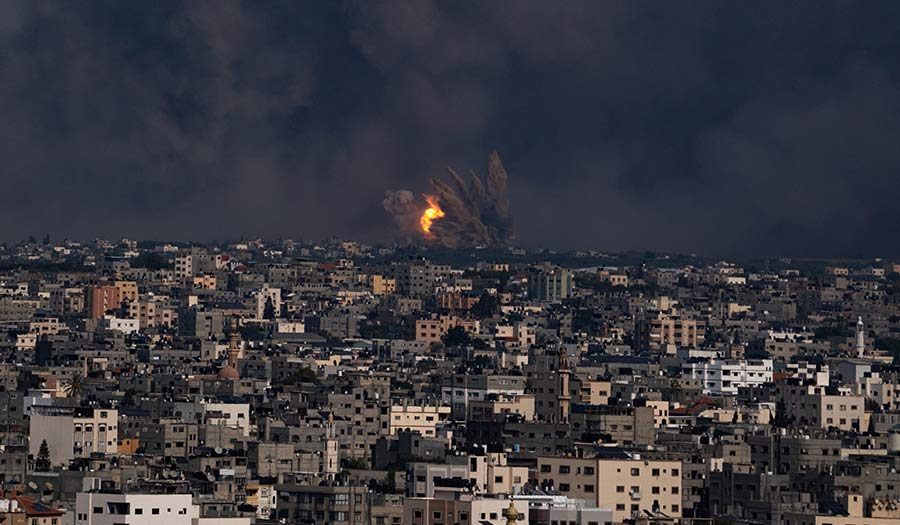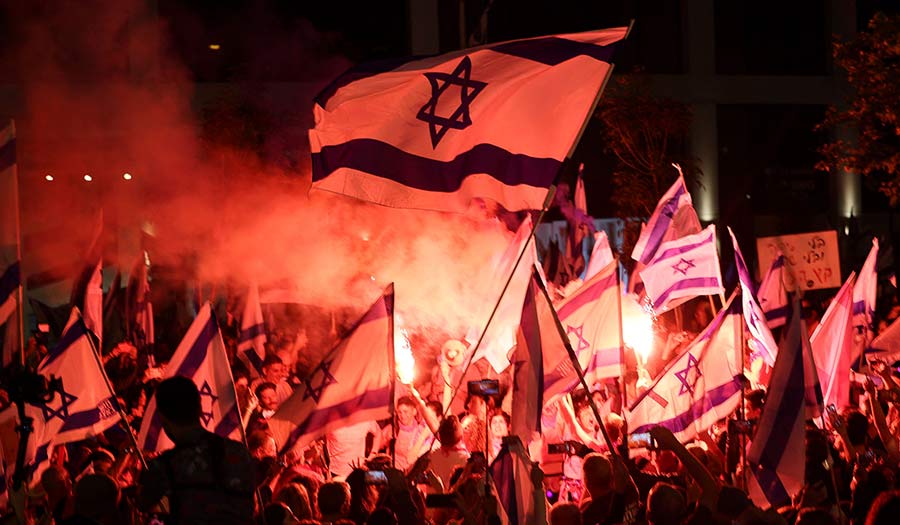 AP/Fatima Shbair
AP/Fatima Shbair
World News Desk
Learn the why behind the headlines.
Subscribe to the Real Truth for FREE news and analysis.
Subscribe NowJERUSALEM (AP) – Israel declared war Sunday as it bombarded the Gaza strip with airstrikes in retaliation for a major surprise attack by Hamas.
The declaration came a day after an unprecedented incursion by Hamas fighters who blew through a fortified border fence and gunned down civilians and soldiers in Israeli communities along the Gaza frontier during a major Jewish holiday.
As many as 1,000 Hamas fighters took part, U.S. Secretary of State Antony Blinken said. The rampage included an assault on a crowded music festival where authorities had removed about 260 bodies by Sunday.
Israel struck back including with airstrikes that flattened a 14-story tower that held Hamas offices. At least 700 people were reported killed in Israel and more than 400 in Gaza.
Here are some key takeaways as the fighting continues.
What Does the War Declaration Mean?
Israel has previously carried out major military campaigns in Lebanon and Gaza that it portrayed as wars, but without a formal declaration.
The declaration gives the green light for Israel to take “significant military steps” against Hamas. It came as the military continued efforts to stamp out the last groups of militants in southern Israel following the attack.
Israel hit more than 800 targets in Gaza by Sunday, its military said. That included airstrikes that leveled much of the town of Beit Hanoun in the enclave’s northeast corner.
Hamas had been using the town as a staging ground for attacks, Israeli Rear Admiral Daniel Hagari told reporters. There was no immediate word on casualties, and most of the community’s population of tens of thousands likely fled before the bombardment.
The leader of the Palestinian Islamic Jihad, which participated in Saturday’s attack, said it was holding more than 30 Israelis among dozens of captives in Gaza. He said they would not be released until all Palestinian prisoners in Israeli jails are freed.
What Has Been the Response from the U.S. and Other Nations?
Defense Secretary Lloyd Austin ordered the Ford carrier strike group to sail to the Eastern Mediterranean to be ready to assist Israel. The deployment—which also includes a host of ships and warplanes—underscores the concern that the United States has in trying to keep the conflict from growing.
Preliminary reports indicated at least four U.S. citizens were killed in the attacks, and seven more were missing, a U.S. official said.
The UN Security Council was holding an emergency meeting about the situation behind closed doors, and Germany’s development minister said her country would review its aid for Palestinian areas.
In Iran—a longtime supporter of Hamas and other militant groups—senior officials praised the incursion. President Ebrahim Raisi spoke by phone with Hamas leader Ismail Haniyeh and Islamic Jihad leader Ziad al-Nakhalah, the state-run IRNA news agency reported Sunday.
Egypt spoke with both sides about a potential cease-fire, but an Egyptian official said Israel was not open to a truce “at this stage.”
A policeman in Egypt opened fire Sunday on Israeli tourists in the city of Alexandria, killing at least two Israelis and one Egyptian, authorities said. The U.S. embassy in Cairo urged Americans in the country to take precautions as the attack could be related to clashes between Israel and Palestinian militants.
Is Anything Being Done to Protect Civilians?
The UN agency for Palestinian refugees said 74,000 people in the Gaza Strip have taken shelter in dozens of its schools following calls from Israel for residents of border areas to evacuate. The number of displaced increased by nearly 50,000 since Saturday, when about 20,000 first moved into UN-operated schools.
The number is likely to increase amid heavy shelling and airstrikes in different parts of the overpopulated and besieged territory of 2 million people, the UNRWA said Sunday.
The agency said one of its schools was directly hit and suffered severe damage, but there were no casualties. Associated Press video from Sunday showed a large crater in the middle of the school, which had sheltered 225 people.
“Schools and other civilian infrastructure, including those sheltering displaced families, must never come under attack,” UNRWA said in a statement.
Cease-fires have stopped major fighting in past rounds of conflict but have always proven shaky. Each agreement in the past has offered a period of calm, but the deeper, underlying issues are rarely addressed, setting the stage for the next round of airstrikes and rockets.
What Prompted the Attack?
Hamas officials cited long-simmering sources of tension including the dispute over the sensitive Al-Aqsa Mosque, which is sacred to both Muslims and Jews. Competing claims over the site, known to Jews as the Temple Mount, have spilled into violence before, including a bloody 11-day war between Israel and Hamas in 2021.
In recent years, Israeli religious nationalists—such as Itamar Ben-Gvir, the national security minister—have increased their visits to the compound. Last week, during the Jewish harvest festival of Sukkot, hundreds of ultra-Orthodox Jews and Israeli activists visited the site, prompting condemnation from Hamas and accusations that Jews were praying there in violation of the status quo agreement.
Hamas also has cited the expansion of Jewish settlements on lands that Palestinians claim for a future state and Mr. Ben-Gvir’s efforts to toughen restrictions on Palestinian prisoners in Israeli jails.
Tensions recently escalated with violent Palestinian protests along the Gaza frontier. In negotiations with Qatar, Egypt and the United Nations, Hamas has pushed for Israeli concessions that could loosen the 17-year blockade on the enclave and help halt a worsening financial crisis that has sharpened public criticism of its rule.
Some political analysts have linked Hamas’ attack to current U.S.-brokered talks on normalization of ties between Israel and Saudi Arabia. So far, reports of possible concessions to Palestinians in the negotiations have involved the occupied West Bank, not Gaza.
What Has Been Happening Recently in a Divided Israel?
The eruption of violence comes at a difficult time for Israel, which is facing the biggest protests in its history over Prime Minister Benjamin Netanyahu’s proposal to overhaul the Supreme Court while he is on trial for corruption.
The protest movement accuses Mr. Netanyahu of making a power grab. That has bitterly divided society and unleashed turmoil within the military, with hundreds of reservists threatening to stop volunteering to report for duty in protest.
Reservists are the backbone of the army, and protests within the ranks have raised concerns about cohesion, operational readiness and power of deterrence as it confronts threats on multiple fronts. Mr. Netanyahu called up “an extensive mobilization of reserve forces” on Saturday.
- Real Truth Magazine Articles
- MIDDLE EAST
 Israel at 75
Israel at 75
More on Related Topics:
- Explainer: Why President Trump’s Proposal on Gaza Is Ringing Alarm Bells in the Region
- Huge Health Challenges Face Gaza Residents Returning to Their Homes
- Gaza Is in Ruins, and It Is Unclear How It Will Be Rebuilt
- After Economic Meltdown and War with Israel, Lebanon’s New Prime Minister Vows to Rebuild
- IAEA Chief: Iran Is Poised to ‘Quite Dramatically’ Increase Stockpile of Near Weapons-grade Uranium


